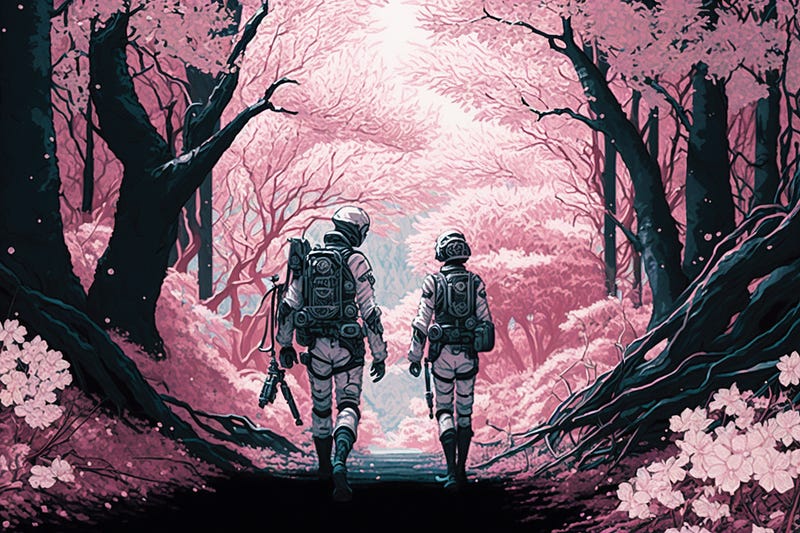Prompting AI Becomes the New In-Demand Workforce Skill

When new technologies arise, workers must adapt their skills to use them. Often, smart users take the tools to find new ways to make money, too. Enter the prompt economy, where entire workforces and new careers are born from the ability to interface with and coax generative AI tools to produce meaningful outputs.
With the prompt economy comes new career opportunities, such as the prompt engineer, AI-powered categories in marketplaces like Fiverr, and entrepreneurs creating and selling prompts, prompting tips, workshops, and events. In addition, entire professions like content creators are now scrambling to learn how to prompt written and visual generative AIs.
This movement does beg the question, is the new prompting skillset a by-product of new advanced technology or a result of primitive generative AI interfaces that the public struggles to use?
While some people are making serious dollars off of prompting — one company issued a job requirement paying an AI prompt engineer $250,000 — I believe the prompt centric-businesses will be a short-lived boom. When considering the need to learn how to prompt, it is fair to assume generative AI tech companies will offer significant improvements to their interfaces.
Why?
In prior generations of technology tools, prompting or basic inputs were commonplace in their early generations. As they evolved, their interfaces become intuitive and adoption across wider audiences occurred. Here are a few parallels with older content-related tools:
· Early search on Jumpstation versus the simplicity of modern Google searches
· Using Photoshop in the 90s to edit photos versus the simplicity of Adobe Lightroom
· Hand coding HTML versus today’s no code plug and play site builders
· MS-DOS prompts versus Windows 10 (yeah, I am that old)
What does this mean for everyday workers who now must interface with AI tools? They must learn to prompt, at least for now.
Prompting Has Become Necessary

Much of the excitement surrounding Chat GPT and a somewhat less enthused integration into Bing is about making the search for answers easier. These easier answers meet businesses' and individuals’ needs to provide answers in a digestible, readable format.
This need for better answers is why Google rushed and botched the launch of Bard. Let’s keep in mind, big business generative text experiments are very early. I expect the Bing GPT tool will evolve further once some of its initial challenges are ironed out.
Until those evolutions include more intuitive interfaces, people will prompt to successfully get meaningful results from generative AI tools.
Writers have rushed to use generative AI tools to create first drafts and serviceable content for their business needs. While these results vary greatly based on the topic and type of content (and Chat GPT’s source data), writers are faced with certain adoption. To get meaningful outputs from these tools, they too will need to learn how to prompt the AI.
Graphic designers are facing a similar technology adoption curve with AI image generators becoming more prevalent. Unlike the Illustration tools, the generative image AIs do not have icon-based tools to create, instead, most of them rely on text inputs via Discord interfaces. As primitive as primitive comes, these inputs will likely evolve, too.
More exciting perhaps are use case specific implementations from companies like Coca-Cola, Fiat, HubSpot, Kia, and Salesforce. These GPT implementations will be trained on defined company or function-specific data and will hopefully be more consistent in their outputs.
In the case of the Fiat Metaverse, coming in 2024, the implementation uses a Microsoft Teams interface to make prompting for car buyers easier. Hopefully, this unique approach with its topic-rich data overcomes some of the current prompting and output challenges experienced on the main ChatGPT platform.
The Problem with Prompting

The inability of everyday users to guide generative AI to desired outcomes is a significant challenge. Adoption will be slower and incomplete until AI inputs improve. At their heart, these inputs serve as data points to help the AI produce better outcomes.
As much as I like using Discord to prompt Midjourney, it can be very frustrating. When I want to evolve images, I simply cannot manually change the image using common illustration tools. Nor can I effectively train the AI with specific directions to alter the image. Often, I am stuck with an unusable image. For a novel hobbyist that might be fine, but professional use requires more certain outcomes.
Keep in mind, Midjourney is considered the best or one of the best art generators available on the public Internet. And yet, it is still necessary to fight with the AI via a third-party interface to improve images.
In reviewing text generators for copywriters, I found similar disconnects between the many fields and the text provided. While some issues are training data related, the prompting interfaces were also limiting. Instead of simply directing the AI to fix x or subtract y, I found myself entering new prompts, struggling to get my thoughts translated into writing.
That’s why crackerjack prompt engineers can make some money. Heck, some people are even selling prompts to the masses on Prompt Base (https://promptbase.com).
Good for them! This is capitalism at its best, rewarding individuals for mastering creativity with a machine. They are capitalizing off piss-poor primitive user interfaces. Welcome to the prompt economy!
How much pain is worth the gain with some generative AI tools?
While some will pay for prompting or learn how to prompt generative AI tools, others will simply take a pass and pay someone to get the work done. Nevertheless, there are real impacts for marketers and creators grappling with generative AI.
Embrace the Prompt Economy

What does the prompt economy mean to an AI-inspired creative? Waiting for AI developers to update their models with the needed and necessary interfaces for widespread adoption is a fool’s errand.
Prompting is the new reality for those who need to learn how to use generative AI. Just like learning how to use a search engine was and is still important, prompting is now a required skill set for creators. It may be a relatively short-lived reality, it may not. However, this is unavoidable for marketers and creators directly responsible for producing content.
As discussed, many in the industry are already grappling with AI adoption. Those who succeed will have the advantage when it comes to winning new opportunities, promotions, and jobs.
Those who fail to adapt will find themselves sliding on the scale of competitive work output. Ultimately, this may be the difference between remaining employable in the market or having to retrain for a new profession.
For example, as my prompting of ChatGPT — and my leveled and more down-to-earth expectations improved — so have the outputs. Here are some tips I found online that were useful, by the way.
A few weeks ago, I developed an exhaustive 1100-word technical article in under 90 minutes using Chat GPT. Given I was not a subject matter expert, that article would have taken me three-to-four hours on my own time, and that’s with almost four years of writing history. Now, I still had a subject matter expert to review the article and verify its accuracy. After all, there’s a lot of unreliable source data in ChatGPT.
The same is true of Midjourney. By learning how to navigate prompting, my images improved. Here are some tips I drafted based on my experiences.
Learning how to prompt will be a useful skill no matter how advanced generative AI interfaces become. There will be times when manual prompting will still be necessary.
A parallel can be drawn to when the World Wide Web was first born. I learned how to hand code webpages and built my organization's first site. Later, understanding code helped me as a blogger who could format posts as needed. Today, low code/no code solutions have advanced to the point that I rarely need to dive into source code, but there are still occasions.
Finally, those who master prompting will be able to sell their talents. We have seen several early examples of these, including PromptBase, digital “influencers” sharing their prompting learnings, using freeware tools for ChatGPT or AI art generators, and yes, the home of current prompt economy, PromptBase.
Making money off the prompt economy will continue. Expect more organizations to embrace generative AI and by default prompting. Some may develop their own interfaces into generators a la Kia.
One can imagine Canva embracing this toolset soon. It added templates for quick-cut music-themed Instagram and TikTok videos. It seems like a natural step for Canva to add prompts for marketers to create written and visual content for its templates.
The danger for these money-makers is longevity. When will generative AI interfaces evolve enough to render their novel skills and intellectual property meaningless? It’s not an if, it’s a when, which brings us to the possible end of the prompt boom.
Will a Startup or a Big Tech Player Step on the Prompt Economy?

It’s a bit ironic that during the low code/no code revolution, we’re suddenly dealing with a text-based prompt economy. For those not familiar, the low code/no code movement allows software developers and even everyday users to build applications without writing code. It’s a natural evolution that has occurred in Internet technology repeatedly: The replacement of manual prompts with clickable interfaces.
Given this context, one can imagine a big tech company like Google, Microsoft or Salesforce ending the prompt economy with one significant tool launch. Prompting obsolescence seems inevitable.
One company even replaced itself recently, specifically Adobe with its Photoshop and Lightroom implementations. Photoshop was and still is an amazing technology. It and its sister application Illustrator have fueled generations of graphic design.
But photographers found the intensive shortcuts and nonintuitive interfaces difficult, spawning entire conferences dedicated to teaching photo editing shortcuts. Retouchers unite! Enter Lightroom, a second application for basic photo editing.
As the years advanced, Lightroom replaced a significant majority of the photo editing tasks in Photoshop. Only the most rigorous actions occur in Photoshop now. And Lightroom is facing another generation of even easier AI-fueled editing apps, many of which perform their tasks on a smartphone.
Easier, simpler, and often performed with one click are the trailblazing characteristics of widespread technology adoption. When generative AI prompting achieves a significant user interface improvement, the prompt economy will enter its twilight, eventually ending. But the generative AI boom will achieve widespread adoption.
One thing is certain, a competitive technology sector will spur innovation. There are a host of big technology players now faced with new generative AI competitors. They are incentivized to build their own or acquire generative AI tools and make them significantly advanced and easier to use. The next wave of AI startups will also be incentivized to top today’s generative tools.
In my mind, it’s not a question of if, but when will we see significantly easier next-generation AI tools.
Given this is AI, don’t underestimate the ability of data science teams to create new interfaces in a rapid fashion. Everything moves faster now. We might see the prompt economy end sooner than anyone expects.
Only time — and maybe AI — will tell.



